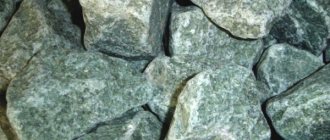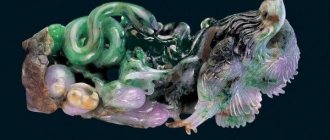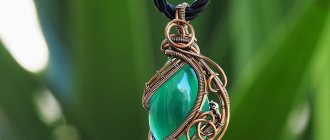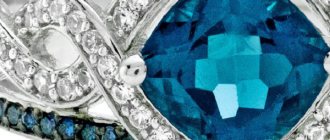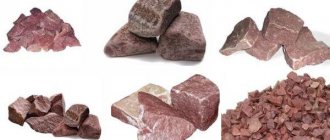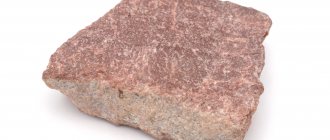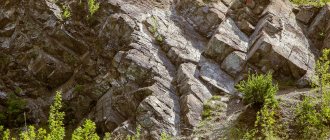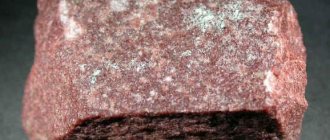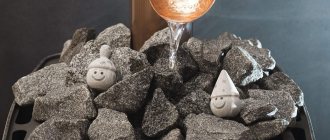Origin
The modern mineralogical name of the stone goes back to the Greek language. "Nephros" means "kidney", respectively, nephritis - "kidney-like", kidney stone. This name is surprisingly suitable for the mineral, since individual samples of it, after processing, acquire an external resemblance to a human kidney in shape and size.
Jade bracelet
Another name for the stone is Chinese jade. Until 1863, both jade itself and jadeite were called jade. Only after the mineralogical discovery made this year was it possible to “sort out” these two minerals.
The history of jade as a mineral used by man is surprisingly ancient. It dates back to the Stone Age: the jade ax was a faithful assistant to the Cro-Magnon hunter. Cave people used it to make knife blades and spear points.
The fact is that jade stones have amazing viscosity - it is comparable to the viscosity of steel. This stone is not as hard as many of its brethren - only 5.5-6.5 Mohs, about the same as toughened glass. But at the same time, it is resistant to impact, does not crush or split. These properties of jade - viscosity combined with hardness - mean high strength, which allows you to make almost any tools from it.
Later, with the development of ancient civilizations, the significance of stone as a technological raw material disappeared, but it acquired a sacred and partly metaphysical meaning.
In medieval China, it was considered the “stone of emperors” and was used to make various religious objects. The Chinese made talismans, amulets, and gravestone decorations from jade, and carved gems from it depicting the main mystical symbols of their culture - lotus, peach, deer, phoenixes, fish and many others.
In Central Asia, Chinese jade was used for cladding buildings and for the manufacture of large objects of religious and cultural significance. The most famous of them are a six-meter statue of Buddha made of milk jade and the tombstone of the conqueror Tamerlane (Timur), made entirely of a rare black variety of this mineral.
Warriors of the Middle Eastern states, in particular the Ottoman Empire, considered green jade to be their symbol, bringing good luck in battle. He often went to decorate the hilts and sheaths of sabers - Persian shamshirs, Turkish fangs, Indian tulwars. Jade rings were also popular among warriors.
A historical description of the stone would be incomplete without mentioning its significance for the Indians of Central America - the Mayans, Aztecs and Incas, who also considered jade sacred and used it to make idols of their deities, breastplates and jewelry. And, for example, in the culture of the aborigines of New Zealand - the Maori - jade was considered a gem that distinguishes the worlds of the living and the dead. Maori often made it into tombstones and other funeral accessories.
In English-language literature, jade is sometimes called "Maori stone".
Jade is considered a semi-precious ornamental stone of the first order (of special value). The cost of jade is on par with the cost of lapis lazuli, malachite, jasper, aventurine, rose quartz and similar minerals.
Health effects
Jade steam works as a professional therapist. When heated with steam, beneficial microelements are released. Entering the body through open skin pores, they speed up metabolism and improve vital processes.
Expert opinion
Lovkachev Boris Petrovich
Bath master who knows everything about steaming
During our tests, the jade charge was exposed to a temperature of 700 degrees. Celsius within a month...if all the stones...scatter once or twice at given temperatures, then Jade behaves very well and does not undergo global decay. This means that when water is supplied to the heater, the lungs will be filled with healing steam, and not with dust from the destruction of stones...
The list of pleasant “consequences” from such a bath includes:
- skin toning;
- improvement of general well-being;
- relieving stress and chronic forms of fatigue, overwork, reducing symptoms of nervous disorders;
- relaxation of muscle tension;
- improving sleep quality, eliminating insomnia;
- reducing the number of bacteria on the skin and organs;
- rejuvenation of the body;
- normalization of pressure;
- kidney cleansing;
- elimination of migraines and headaches;
- improvement of immunity;
- cure colds;
- healing of small wounds on the skin.
It is worth remembering that jade baths are contraindicated for people with cancer, heart pathologies, tuberculosis, and any diseases in the acute stage. It is not recommended to visit the steam room, including those with nephritis, with purulent inflammations on the skin and in the respiratory area (for example, with sinusitis).
Physicochemical characteristics
Chemical characteristics of jade: calcium hydroxysilicate with admixtures of magnesium, iron, and occasionally vanadium and chromium. Refers to minerals that have a silica base. It is formed where magma, coming to the surface, mixed with sedimentary rocks.
The main color of jade is whitish, close to milky. The metals included in its composition change the color of the mineral towards green and blue colors, as well as some others.
The density and hardness are average, the luster is glassy, greasy, the degree of transparency varies from specimen to specimen. As a rule, ornamental stones are cloudy and opaque.
| Property | Description |
| Formula | Ca2(Mg,Fe)5[Si4O11]2(OH)2 |
| Color | Shades of green, white, gray. |
| Shine | Glassy, greasy. |
| Transparency | From translucent in chips and plates 1-1.5 cm wide to opaque. |
| Hardness | 5,5-6,5 |
| Cleavage | Absent |
| Kink | Conchoidal, . |
| Density | 2.95-3.4 g/cm³ |
Maintenance during use
Jade does not require particularly fancy care. Simple hygiene procedures with a minimum of actions are enough for him.
Before installation or placing in the oven, the stones must be washed with salt water. The material is soaked in a concentrated solution for 2-3 hours, then treated with a soft brush or rag, and washed with clean liquid.
Completely dried minerals can be used. A similar procedure is carried out every 3-6 months in the future. This allows you to thoroughly remove the deposits of fat, sweat, harmful substances, restore shine and harden for greater strength.
The rest of the time, jade can be cleaned with delicate dishwashing liquids and a solution of baby soap. It is important to remember that abrasives, scrubbing and acidic products are PROHIBITED.
Mining locations
At least one deposit of Chinese jade exists on every continent, excluding Antarctica (but perhaps they simply have not yet been discovered there). Mining is carried out by quarry method, as well as in placers. Chinese jade is sometimes found in marble, slate and gneiss rocks.
Main deposits:
- China - provinces of Hotan, Liaoning, Henan.
- Russia - Ospinskoye (Sayan mountain range), Buromskoye and Golyubinskoye (Vitim River).
- USA - states of California, Montana, Alaska and Washington.
- Europe - Poland.
- New Zealand is everywhere.
It is also found in Myanmar, Mexico, Canada and various parts of the African continent. At the same time, stones of Chinese and New Zealand origin are most valued.
How to distinguish a jade stone from a jadeite
Experienced collectors know how to identify natural jade from other stones based on physical properties and color, but even they are often confused about the difference between jade and jadeite, because both of these stones belong to the same group - jade. High-quality products are extremely similar in appearance. But there are ways to distinguish a jade stone from a jadeite, based on accurate indicators.
Using special equipment, the density of the stone is determined. In jadeite it is literally two tenths higher. High-precision equipment is what anyone who wants to know the stone with the highest probability will need.
Using a magnifying glass or microscope, look at the surface of the stone. The abundance of tangled fibers indicates that the stone is jade, and the fine-grained, “shagreen” surface is most often found in jadeite. This is not true for painted or bleached stones, as well as stones glued together.
Color variety
The main color of a “kidney stone” is traditionally considered to be light, cloudy green. This is a classic color known to everyone, but in fact there are other types of colors in nature:
- milky white;
Milky white jade - yellowish;
Yellow bracelet with jade - grassy;
Grass-colored jade - swamp;
Swamp-colored jade - bright green.
Bright green jade
This stone has shades of all varieties of green, from very light to dark, almost black. Black specimens, however, are rare; red and blue ones are even rarer (and therefore very highly valued).
The color is due to impurities of various metals.
Different types of jade have different prices: light green is the least valued, milky white (the color of lamb fat) is slightly more expensive, then the price of jade increases in proportion to the density of the color.
Therefore, gems from New Zealand are considered one of the most expensive - bright green, almost emerald in color.
Varieties of jade do not have their own names; in mineralogy and gemology, all subspecies are the same mineral.
“Kidney stone”, which has a uniform color, is valued most highly; any inclusions, color variations, stripes and spots reduce the price. The average cost of a grass-green stone is several dollars per gram; gems weighing more than 10 grams are priced more expensive. The price for red, black and blue copies is set separately.
A little about jade
Jade is mined in Mexico, Russia, New Zealand, Canada and many other parts of the globe. Colors may vary in different regions. This is due to the different composition of the mineral. The colored species are generally called actinolites.
Brown shades indicate an admixture of iron, black shades indicate an excess of iron, pink shades indicate the presence of a large amount of magnesium. The green color indicates that the specimen is rich in chromium. White color or complete absence of pigment (transparency) is found in pure breeds without impurities. They are called tremolites and are found much less frequently than actinolites.
There is also a subtype chromite/hematite. He is a mixture of two main classes. The main part of the area has impurities and, accordingly, color. But the surface is simultaneously painted with transparent or white stripes.
Jade is an expensive pleasure. It is not without reason that a bathhouse decorated with mineral has long been considered a sign of financial success for the owner. The high cost is caused by the complex extraction procedure and composition. Performance qualities increase the price even more.
Nephritotherapy
The effect of this mineral on the human body is specific. The decisive healing property of jade is considered to be its healing effect on the genitourinary system. This stone relieves pain in various diseases of the kidneys, bladder, and can affect the gastrointestinal tract.
A manifestation of the healing properties of jade is its ability to drive away nightmares and ease fears and phobias. The stone has a healing effect on the nervous system, but has contraindications, mainly in accordance with the laws of astrology.
Ancient healers recommended that pregnant women wear jade jewelry around the abdomen and waist, for example, in the form of stacked belts. It was believed that such amulets could reduce pain during contractions and generally make pregnancy easier.
Ancient healers also endowed jade belts (archaeologists know of such finds from Central Asia) with the ability to relieve menstrual pain, and in men, to have a beneficial effect on potency. From the point of view of the indigenous New Zealanders - the Maori - the bright green stones from the archipelago have a powerful sedative effect, promoting calm and relaxation.
To summarize: the beneficial properties of jade are, firstly, a healing effect on the organs of the genitourinary system, and secondly, a mitigation of symptoms and partial elimination of neuroses and other phobic mental disorders.
FAQ
What does tumbled jade mean?
This implies a tumbled processing method. When mined, the mineral does not have a very attractive appearance. Extraction from deposits occurs through explosions. Therefore, the shape is uneven. To restore the jade's aesthetics, it is placed in a crusher to give it an identical shape. Then the pieces, together with water, sand, and corundum, are placed in a tumbling apparatus in the form of a barrel with teeth on the walls. During rotation, the abrasives grind the stones to round, smooth surfaces. The process is reminiscent of turning pebbles in the sea, but occurs at an accelerated rate. The surface is slightly rough to the touch. Tumbled jade is ideal for a bathhouse because smooth stones will slide uncomfortably in an atmosphere of high humidity.
Are all types of jade suitable for baths?
The preferred type is actinolite with a hardness of at least 5.5. As a rule, these stones are gray or green in color. Samples containing talc and serpentinite do not reach this indicator. Jewelry types are not as resistant to temperature changes.
How to check the quality of jade if it has already been placed in the steam room?
You can use the following life hack. Heat the oven to the maximum, raise the maximum possible temperature in the room. Throw ice water onto the heated stones. Synthetic replacements are deformed, melted, or quickly cooled from cold water. Natural jade, even after a change in temperature, will retain heat for a long time and will not change shape up to 1200C.
Is it possible to place jade directly on the bottom of the oven?
It is possible and necessary. Often, jade is placed as the first layer under jadeite to reduce the cost of the furnace contents without losing the quality of the steam. The mineral withstands contact with fire. “It’s good to put stainless steel as the bottom layer so that there is a layer between the open fire and the stone... it can be applied to porphyrite or jade - any stone will last longer with such a layer.” Bath attendant Alexey parilochka.com
Which country is the best jade from?
New Zealand stone is considered to be the highest quality. There, the most homogeneous and dense specimens with beautiful colors are born. From the vastness of Russia, the most competitively capable Siberian option. Slightly lower quality jade from Canada, USA, Kazakhstan, Mexico.
How to choose the size of the stone?
The largest blocks are 12-25 cm in size. It is suitable for laying in large direct-heated ovens. 8-12 cm are optimal for substrates in wood-burning stoves, heaters, and fireplaces. Minerals from 6 to 8 cm work perfectly in electric stoves. The smallest 4-5 cm are used for decoration, massages, and spot display.
Jade is one of the best stones for finishing a bath and creating steam. Beautiful appearance, healing effects, emphasizing status - all this is inherent in the material.
Magical Features
The unique magical property of jade is considered to be the ability to indicate to the owner the truth or error of decisions made.
If the owner has made the wrong choice in an area that is important to him or her, has made an erroneous decision, the color of the stone in his amulet will fade or become cloudy within a few days after the start of the wrong actions.
The magical properties of this stone depend on the traditions of the culture that uses it. Thus, the Chinese considered white jade to be the “imperial stone”, helping to pacify passions and develop a calm, cool view of the world around them. This helped the emperor make the right decisions.
In Central American Indian cultures, this gem was the stone of caciques - priests and shamans. Images of gods, spirits and demons were often carved from it. A person possessing such an amulet acquired a direct connection with the deity to whom the talisman was dedicated.
The Aztecs and Mayans were surprised that the Spaniards, greedy for the sacred gold in Indian cultures, did not pay any attention to jade. From the point of view of the Indians, this gem and gold were of equal value.
The classic Chinese green jade, set in silver, is considered in many magical traditions to be a talisman against the evil eye. Inserted into the apple on the hilt of a sword, it will endow the owner with military luck and strengthen the hand.
Rare red jades are distinguished by their valuable ability to protect a home from natural disasters.
In Central Asia, black jade was used to make objects related to the veneration of the dead (for example, the famous sarcophagus of the conqueror Timur). The Maoris endowed their famous gems with the same property - the separation of the world of the living and the kingdom of the dead. In their culture, this mineral was of such great importance that since 1997, the New Zealand authorities have transferred all existing deposits to the management of the descendants of the aborigines.
Amulet with jade
In the world of magic, jade has the universal quality of enhancing the effect of other amulets and amulets. But for this you need to be able to use it correctly.
How to use
The method of use depends on the form in which the person acquired the jade:
- fine scattering - for massage and spot application with heated stones, decoration on shelves, in bowls, vases, detailed finishing of stoves and furniture;
- large scattering - in heaters and for decoration;
- bricks, tiles, blocks - for laying out entire walls, inserting them, finishing the stove, flooring, making furniture for procedures and relaxing in the steam room.
In all cases, the mineral can and should be periodically moistened with water in order to generate a new portion of steam.
With the help of the warmth of jade, blood circulation increases and improves... The jade massage table is used for spa treatments: wraps, peelings, thalassotherapy, mud therapy, soap massage.
Zodiac compatibility
Jade is an absolutely “earthly” gem, clearly associated with the element of Gaia, that is, the Earth. According to the horoscope, this stone is suitable for many signs, but best of all - Virgo, Aquarius and Pisces. Oddly enough, Taurus does not like the pebble; Libra should wear it with some caution.
Only red jade is suitable for the zodiac sign of the element of Fire, especially Leo!
| Zodiac sign | Compatibility (“+++” – fits perfectly, “+” – can be worn, “-” – strictly contraindicated) |
| Aries | + |
| Taurus | + |
| Twins | + |
| Cancer | + |
| a lion | + |
| Virgo | + |
| Scales | +++ |
| Scorpion | + |
| Sagittarius | + |
| Capricorn | + |
| Aquarius | + |
| Fish | + |
(“+++” – fits perfectly, “+” – can be worn, “-” – is strictly contraindicated)
Compatibility with other stones
Jade products are combined with other stones dedicated to the earth - Gaia. First of all this:
- cacholong;
- chalcedony and agate;
- malachite;
- onyx;
- turquoise;
- sarder;
- morion.
An exception to this list in terms of planetary compatibility is jasper.
You can wear jade simultaneously with any Water stone, for example, emerald, aquamarine, opal or peridot.
Earth is a calm and peaceful element that gets along well with any other element except Fire: under its influence the Earth weakens.
Therefore, you should not combine jades with jewelry:
- with ruby;
- diamond (diamond);
- garnet (almandine and pyrope);
- coral;
- heliolite.
Amulet with jade and emerald
The proximity to Air minerals, meaning inconstancy and frivolity, is neutral - the gems will not react with each other, since they are too different. In the lists of Air stones:
- rhinestone;
- amethyst;
- rose quartz;
- tourmaline;
- topaz;
- golden beryl
and other translucent and transparent gems.
Medicinal properties
Healing characteristics of jade:
- improves the functioning of the genitourinary system;
- accelerates regeneration processes;
- reduces pain in kidney or bladder diseases;
- normalizes the functioning of the stomach and intestines;
- relieves bad dreams and phobias;
- activates metabolic processes;
- improves blood circulation;
- has a positive effect on the functioning of the nervous system.
Interesting! Jade is a warm mineral whose temperature does not decrease depending on weather conditions.
Regular use of the stone will help improve vision and hearing, and also reduce the risk of developing pathologies in the owner’s body. Water infused with nugget cleanses the body of toxic substances and toxins and suppresses the development of inflammatory processes. Regular use of a blood-colored jade amulet will help in the treatment of cardiovascular diseases.
Application area
The scope of use of jade in jewelry is unusually wide: souvenirs, figurines, figures and gems are made from it. Stones of special purity are used as inserts in jewelry - earrings, pendants and tiaras. Jade bracelets and beads are often found.
As a rule, the metal for the frame is silver, both simple and gilded.
Gold is not used due to the inconsistency of Chinese jade in value.
Jade massagers of various designs are produced specifically for massage.
How to recognize a fake
You can distinguish a natural stone from a fake by its temperature combined with hardness. Jade is always warm to the touch, a little warmer than the surrounding air, like plastic, but the stone is harder than plastic. It will not be scratched by a needle or knife blade unless you apply special effort.
Jade stone
If you examine a thin plate of stone against the light, you can see many thin longitudinal fibers forming a complex pattern. Fake stones are homogeneous.
The most reliable way to evaluate is by sound. When the thin plates (scales) of the gem are tapped against each other, they emit a melodious ringing.
How to choose jade
Jade is actively counterfeited due to its popularity and high cost. Unscrupulous manufacturers often try to make money on cheap synthetic analogues of stone.
To avoid becoming a victim of a scammer, you need to check the material before purchasing:
Refusal to present or questionable stamps clearly indicate forgery.
Don't be shy to ask for a certificate.- Test for strength. Of course, no normal seller will allow products to be damaged. However, demo pieces can be used for this purpose. Real jade will not crack when the stones hit each other, and there will be no scratches left on it from a metal object or nail file.
- Listen to the sound . The natural mineral “sings” loudly. Synthetic analogues produce a flat, dull sound or do not produce it at all.
- Consider the appearance . Even small pieces of jade always have an even cut. The natural product is never pricked, so its edges are processed until smooth.
- Pay attention to the form and price tag . For jade, a round or square shape is natural. The figures are less common and a priori cost a lot of money due to the high cost of processing. If a unique shape is offered for a small fee, you have synthetics.
Expert opinion
Lovkachev Boris Petrovich
Bath master who knows everything about steaming
Of course, it is recommended to buy minerals strictly from specialized companies. Multidisciplinary manufacturers usually do not have the technical ability to produce high-quality natural products.
It is also important to look at the variety. The higher it is, the longer the expected service life:
- 1st grade – up to 25 years, strength 900 MPa;
- 2nd grade – up to 20 years, strength 700 MPa;
- Grade 3 – up to 15 years, strength 460 MPa.
Jade without white and grayish inclusions is ideal for baths. Such specimens distribute heat better.
